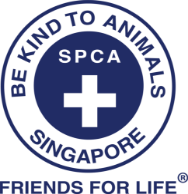Pet Cafes: Yea or Nay
Pet and animal cafes have been springing up worldwide, a delight to those looking for the transient company of our furry friends. From the cat and dog cafes of old, to owl cafes in Tokyo, to the exotic menageries in Bangkok with African wild cats and raccoons. These outlets may seem great for family fun and exposing children to animal interactions. But for the animals, their new ‘home’ could be a place of distress and suffering.
Distress Close to Home

Image credit: Screengrab from Zigzagzooey/TikTok
In 2023, the SPCA investigated three cases involving cat cafes and one case involving a dog cafe. In February 2024, I Love Cat Café came under public scrutiny after multiple feedback providers reported concerns about potential neglect. When we visited the premises, we observed signs of compromised welfare. More than half of the seven cats looked malnourished. Five of them were allowed to roam the space, while the remaining two shared a single cage. The cage did not have a water source inside and the litter box was soiled. In the free-roaming space, the five cats shared just three litter boxes and one water bowl. The cat tree was unstable, and the tunnels were dirty and covered with fur. When the cafe closed for the day, ventilation was limited to just one fan with no openings for exchange of air.
The owner’s alleged intention to provide a refuge for rescued cats had ended up in a distressing reality for the cats. Two of them were identified as being in poorer health and in need of immediate veterinary attention. The SPCA considers neglect (failure to meet basic needs) to be a breach of animal welfare standards. All seven cats have since been rehomed with the cooperation of the owner and the help of an independent rescuer, and we understand that the cafe had ceased operations shortly after the investigation.
To Support or Not
While there is no need to take animal cafes off your bucket list immediately, here are some tips for deciding if a cafe is worth your support. Remember, your patronage is a sign of endorsement and it provides the revenue that keeps a cafe in business.
With the internet at our fingertips, it is easy to see what others are saying about the cafe we plan to visit. Consider the qualitative comments, not just the ratings, and pay attention to feedback on environmental hygiene, the physical appearance of the animals (proxy of health), and their willingness to be among human company (withdrawal may signal discomfort).
Some red flags include wildlife and exotics, and pet breeds that are unlikely to thrive in the given climate. For example, huskies have a thick, double coat that helps them stay warm in their natural cold habitat. When transplanted to a tropical climate like Singapore’s, it is almost impossible to replicate the conditions that allow them to thrive in their native environment and the unfortunate result is suboptimal welfare.
Similarly, wildlife and exotics in captivity do not have the opportunities to engage in their instinctive behaviours. Given their undomesticated nature, proximity to humans and forced interactions can be sources of stress that have downstream effects on the health of these animals. They are best left to live freely in their natural habitats and admired from afar.
With domestic animals like cats and dogs, their breed could give some idea of where they came from. If many of the animals are pedigrees, they may have been bred for the sole purpose of the cafe business. By visiting such cafes, we are indirectly fuelling the breeding industry. Instead, choose to support cafes that build their work around rescued animals.
Observe whether the animals have free choice by way of sufficient space, resources (e.g. litter boxes, water bowls, toys), and options for retreat away from humans and fellow animals (e.g. boxes or a separate nook). If all they have is a common space, that should trigger alarm bells for you.
In addition, note whether the cafe imposes a cap on the number of visitors. If unrestricted, the surge in footfall during peak periods can take a toll on the animals as they are forced into even closer proximity with humans.
Be attuned to how the cafe staff talk about their animals. If they objectify the animals, speak of them as commodities, and are more concerned about their human visitors at the expense of the animals, it suggests that the cafe is mainly interested in profit-making. Instead, choose to support cafes that have animal welfare as their focus. These cafes will place a premium on their animals’ health (e.g. grooming them and bringing them for regular vet visits), encourage adoptions over buying a pet, and some even do rescue work to help animals escape the harsh street life for good.
The Bottomline
Many of us adore animals and enjoy their companionship, but we often forget that they may have different preferences and a whole other love language.
No matter where we encounter them, let’s give some thought to our actions and choices as they relate to animals. The lives of our furriends will be better for it.




